Damage Mechanism of Prefabricated Fracture-Grouted Rock Specimens under the Action of Dry and Wet Cycles
Abstract
:1. Introduction
2. Materials and Methods
2.1. Materials
2.2. Test Program
- (1)
- Specimen preparation and maintenance, as outlined in Section 2.1.
- (2)
- Dry and wet cycle specimens: The dry–wet cycle test of rock samples is divided into drying and soaking stage. The soaking stage test is conducted using a homemade immersion bucket and a 2RS-1 vacuum pump, whereas the drying stage test is conducted in an oven. The fissure-grouted rock specimens were treated with 0, 5, 10, and 20 wet and dry cycles. The duration of immersion and drying was chosen to be 8 h to simulate the operation time of pumped storage in abandoned mines [27]. In addition, the tests were conducted using evacuated water immersion and complete drying in an oven to amplify the effect of the wet and dry cycles on the rock specimens. One dry and wet cycle is defined as: the fissure-grouted rock specimen is dried in a constant temperature and humidity oven at 60 °C for 8 h, and then the specimen is placed in an immersion bucket [28,29]. According to GB/T23561.5-2009 [30] preparation for water-filled specimens, a vacuum pump is used to continuously extract the air in the tank for 1 h, and the specimens are soaked for 8 h [31]. The fissure-grouted rock specimen is periodically weighed throughout the soaking stage. When the weight of the sample stops unchanged, the fissure-grouted rock sample is considered saturated with water.
- (3)
- The HC-U81 concrete ultrasonic tester was used to measure the wave velocity of rock specimens following the effects of dry and wet cycles. Wave velocity tests were conducted on specimens with various damage characteristics. Petroleum jelly was applied to the fissure of grouting rock specimen’s surface before measuring the wave velocity to ensure that the metal probe of the wave velocity meter fits snugly against the specimen. The wave velocity of the fracture-grouted rock specimen was measured using the compressional metal probe numerous times. Moreover, the average result was utilized to obtain the final wave velocity measurement.
- (4)
- Rock specimens’ uniaxial compression mechanical characteristics following dry and wet cycles: The device used for the uniaxial compression test is the RMT-150B Rock Mechanics Test System developed by the Wuhan Institute of Geotechnics, Chinese Academy of Sciences. The axial displacement was controlled using the displacement transducer that came with the mechanical test system. Uniaxial compression tests are all loaded in a displacement-controlled manner and continuously loaded until the rock sample is completely destroyed, and the crushed specimens are collected after the experiments are completed.
- (5)
- Rock specimens following dry and wet cycles are tested for acoustic emission: During the uniaxial compression test, the DS5-8B full-information acoustic emission signal analyzer was used to record the acoustic emission signal during the test, with the acquisition threshold set at 40 dB. A full-information acoustic emission signal analyzer is activated after the uniaxial compression starts loading to collect acoustic emission data until the fracture-grouted rock specimens rupture.
2.3. Methods
3. Results and Discussion
3.1. Wave Velocity Degradation
3.2. Degradation of Mechanical Properties of the Specimen
3.3. Specimen Acoustic Emission Characterization
3.4. Discussion
4. Conclusions
- (1)
- The wave velocity, peak strength, and elastic modulus of the fissure-grouted rock specimens decrease in a linear connection as a result of wet and dry cycle action on the rock specimens. This linear relationship is negatively connected with the number of wet and dry cycles. Additionally, the reduction rate slows down as the quantity of wet and dry cycles rises, indicating that the impact of wet and dry cycles on specimens of fracture-grouted rock gradually diminishes.
- (2)
- The damage variables after wet and dry cycling can better reflect the damage evolution process of rock specimens after wet and dry cycling; the change in damage variables went through a smooth phase, a slowly increasing phase, and a steeply rising phase, which is consistent with the change law of the stress–strain curve.
- (3)
- A damage intrinsic model for fracture-grouted rock specimens is introduced, considering the impact of wet and dry cycles. The model uses the rock material parameters m to reflect the impact of rock fractures, laminations, anisotropy, and other characteristics on its mechanical properties. The established damage constitutive model can describe the damage characteristics of the surrounding rock of the abandoned mine pumped storage, and can provide a model reference for the understanding of the instability mechanism of the abandoned mine pumped storage.
Author Contributions
Funding
Data Availability Statement
Conflicts of Interest
References
- Sun, Y.; Zhang, P.; Yan, W.; Wu, J.; Yan, F. Grouting Material Development and Dynamic Grouting Test of Broken Rock Mass. J. Mater. Civ. Eng. 2022, 34, 1–15. [Google Scholar] [CrossRef]
- Chen, G.B.; Li, Y.; Li, T.; Zhang, G.H. Mechanical response and deterioration mechanism of sandstone with intermittent joints under drying-saturation circulation. Q. J. Eng. Geol. Hydrogeol. 2023, 56. [Google Scholar] [CrossRef]
- Zhi, G.; Ju, J.; Liu, R.; Yang, R.; Fang, Z.; Zhang, C. Water-rock interaction and its influence on water quality in the underground reservoir. J. Min. Saf. Eng. 2022, 39, 779–785. [Google Scholar] [CrossRef]
- Ma, D.; Miao, X.X.; Chen, Z.Q.; Mao, X.B. Experimental Investigation of Seepage Properties of Fractured Rocks Under Different Confining Pressures. Rock Mech. Rock Eng. 2013, 46, 1135–1144. [Google Scholar] [CrossRef]
- Xing, K.; Zhou, Z.; Yang, H.; Liu, B.C. Macro-meso freeze-thaw damage mechanism of soil-rock mixtures with different rock contents. Int. J. Pavement Eng. 2020, 21, 9–19. [Google Scholar] [CrossRef]
- Vergara, M.R.; Triantafyllidis, T. Influence of Water Content on the Mechanical Properties of an Argillaceous Swelling Rock. Rock Mech. Rock Eng. 2016, 49, 2555–2568. [Google Scholar] [CrossRef]
- Liu, X.; Zeng, W.; Liang, L.; Xiong, J. Prediction of Borehole Wall Collapse Cycle in Longmaxi Shale. Spec. Oil Gas Reserv. 2016, 23, 130–133+157–158. [Google Scholar] [CrossRef]
- Eshiet, K.I.; Sheng, Y.; Ye, J.Q. Microscopic modelling of the hydraulic fracturing process. Environ. Earth Sci. 2013, 68, 1169–1186. [Google Scholar] [CrossRef]
- Yu, L.Q.; Yao, Q.L.; Chong, Z.H.; Li, Y.H.; Xu, Q.; Xie, H.X.; Ye, P.Y. Mechanical and micro-structural damage mechanisms of coal samples treated with dry-wet cycles. Eng. Geol. 2022, 304, 1–14. [Google Scholar] [CrossRef]
- Flukiger, F.; Bernard, D. A new numerical model for pore scale dissolution of calcite due to CO2 saturated water flow in 3D realistic geometry: Principles and first results. Chem. Geol. 2009, 265, 171–180. [Google Scholar] [CrossRef]
- M’Nassri, S.; Lucas, Y.; Schafer, G.; Dridi, L.; Majdoub, R. Coupled hydrogeochemical modelling using KIRMAT to assess water-rock interaction in a saline aquifer in central-eastern Tunisia. Appl. Geochem. 2019, 102, 229–242. [Google Scholar] [CrossRef]
- Wei, S.J.; Tomac, I. Numerical evaluation of Failure Assessment Diagram (FAD) for hydraulic fracture propagation in sandstone. Eng. Fract. Mech. 2022, 263, 1–16. [Google Scholar] [CrossRef]
- Schmalholz, S.M.; Moulas, E.; Plumper, O.; Myasnikov, A.V.; Podladchikov, Y.Y. 2D Hydro-Mechanical-Chemical Modeling of (De)hydration Reactions in Deforming Heterogeneous Rock: The Periclase-Brucite Model Reaction. Geochem. Geophys. Geosyst. 2020, 21, e2020GC009351. [Google Scholar] [CrossRef]
- Uno, M.; Koyanagawa, K.; Kasahara, H.; Okamoto, A.; Tsuchiya, N. Volatile-consuming reactions fracture rocks and self-accelerate fluid flow in the lithosphere. Proc. Natl. Acad. Sci. USA 2022, 119, e2110776118. [Google Scholar] [CrossRef]
- Wang, W.; Gu, F.; He, L.; Liu, Z.; Cao, T.; Li, G. Experimental study on deteriorating characteristics of metamorphic sandstone mechanical parameters under the effect of wetting -drying cycles. J. Water Resour. Water Eng. 2022, 33, 179–185+193. [Google Scholar] [CrossRef]
- Chai, S.; Song, L.; Zhou, W.; Fu, X.; Zhou, Y. Experiment on the Effect of Different Water-Rock Interactions on the Deterioration of Filled Jointed Rock. J. Jilin Univ. 2022, 52, 1–11. [Google Scholar] [CrossRef]
- Majeed, Y.; Abu Bakar, M.Z. Water Saturation Influences on Engineering Properties of Selected Sedimentary Rocks of Pakistan. J. Min. Sci. 2018, 54, 914–930. [Google Scholar] [CrossRef]
- Verstrynge, E.; Adriaens, R.; Elsen, J.; Van Balen, K. Multi-scale analysis on the influence of moisture on the mechanical behavior of ferruginous sandstone. Constr. Build. Mater. 2014, 54, 78–90. [Google Scholar] [CrossRef]
- Xiong, J.; Li, Y.; Liu, X.; Liang, L.; Ding, Y.; Hou, L. Influences of water–rock interaction on the physical and mechanical properties of shales: A case study of the Lower Silurian Longmaxi Formation in the Sichuan Basin. Nat. Gas Ind. 2022, 42, 190–201. [Google Scholar] [CrossRef]
- Song, Z.; Cheng, Y.; Yang, T.; Huo, R.; Wang, J.; Liu, X. Experimental study of the influence of osmotic pressure on pore structure evolution in limestone. Rock Soil Mech. 2019, 40, 4607–4619+4643. [Google Scholar] [CrossRef]
- Cuisinier, O.; Masrouri, F.; Mehenni, A. Alteration of the Hydromechanical Performances of a Stabilized Compacted Soil Exposed to Successive Wetting-Drying Cycles. J. Mater. Civ. Eng. 2020, 32, 1–9. [Google Scholar] [CrossRef]
- Wang, J.; Liu, M.; Qiu, Z.; Zhang, H.; Bai, J. Effects of Wetting–Drying Cycles on Strain–Stress Relationship from Triaxial Test of a Mudstone Mixture. Geotech. Geol. Eng. 2019, 37, 1039–1045. [Google Scholar] [CrossRef]
- Tanikawa, W.; Shimamoto, T. Comparison of Klinkenberg-corrected gas permeability and water permeability in sedimentary rocks. Int. J. Rock Mech. Min. Sci. 2009, 46, 229–238. [Google Scholar] [CrossRef] [Green Version]
- Qin, Z.; Fu, H.; Chen, X. A study on altered granite meso-damage mechanisms due to water invasion-water loss cycles. Environ. Earth Sci. 2019, 78, 428. [Google Scholar] [CrossRef]
- Liu, Q.; Wu, B.; Fu, Q.; Chen, Q.; Liu, F. New Testing Device for the Grouting Reinforcement Performance of Fractured Rocks. J. Eng. Sci. Technol. Rev. 2022, 15, 168–176. [Google Scholar] [CrossRef]
- Zhang, J.; Xu, R.; Liu, Y.; Zhang, H.; Qing, X.; Chen, M. Experimental study on mechanical properties of grouted fractured rock mass under freeze-thaw cycles. J. Exp. Mech. 2021, 36, 378–388. [Google Scholar] [CrossRef]
- Zheng, H.; Zhang, Z.; Wu, H.; Lei, X. Study on the daily optimized dispatching and economic operation of cascade pumping stations in water conveyance system. J. Hydraul. Eng. 2016, 47, 1558–1565. [Google Scholar] [CrossRef]
- Xu, J.; Li, Y.; Ren, C.; Lan, W. Damage of saline intact loess after dry-wet and its interpretation based on SEM and NMR. Soils Found. 2020, 60, 911–928. [Google Scholar] [CrossRef]
- Zhang, F.; Jiang, A.; Yang, X. Shear creep experiments and modeling of granite under dry-wet cycling. Bull. Eng. Geol. Environ. 2021, 80, 5897–5908. [Google Scholar] [CrossRef]
- GB/T 23561.5-2009; Methods for Determining the Physical and Mechanical Properties of Coal and Rock. The National Standard Compilation Groups of People’s Republic of China: Beijing, China, 2009. (In Chinese)
- Chai, S.; Zhang, L. Study on damage mechanism of alkali activated fly ash mineral powder modified expansive soil under drying wetting freezing thawing cycles. Eng. Mech. 2023, 40, 1–12. [Google Scholar] [CrossRef]
- Fu, P.; Qi, X.; Wang, S.; Geng, D.; Ke, T. Study on damage law of layered composite rock after high temperature. J. Archit. Civ. Eng. 2022, 40, 1–13. Available online: https://kns.cnki.net/kcms/detail/61.1442.tu.20221108.0927.002.html (accessed on 13 February 2023).
- Liu, J.; Zhu, X.; Xu, L.; Zhang, S. Study on Damage Evolution Law of Granite after High Temperature Cooling. Coal Technol. 2021, 40, 30–33. [Google Scholar] [CrossRef]
- Wang, R.; Ren, M.; Liu, J.; Zhao, L.; Xu, S.; Shi, T. Study on Correlation Between Rock Wave Velocity and Strength Parameters. Min. Res. Dev. 2021, 41, 87–91. [Google Scholar] [CrossRef]
- Zhang, C.; Song, Z.; Zhao, Y.; Han, P.; Teng, T. DEM-CFD coupling analysis of broken rock mass movement in underground reservoir of coal mine. J. Min. Strat. Control. Eng. 2021, 3, 85–95. [Google Scholar] [CrossRef]
- Zhang, Z. Study on the Characteristics of Swelling-Creep and Damage of Soft Rock under Hydration; Hunan University of Science and Technology: Xiangtan, China, 2018. [Google Scholar]
- Zhang, H.; Guo, J.; Sun, F.; Shi, X.; Zhu, Z. Acoustic Emission and Fracture Evolution Characteristics of Granite under Different Testing and Moisture Conditions. Chin. J. High Press. Phys. 2022, 36, 77–91. [Google Scholar] [CrossRef]
- Chen, D.; Ji, H.; Fu, Z. Evaluation Method of Crack Initiation Stress in Brittle Rocks Based on Acoustic Emission b-Value Evolution. Met. Mine 2022, 52, 1–12. Available online: https://kns.cnki.net/kcms/detail/34.1055.TD.20221021.1752.004.html (accessed on 13 February 2023).
- Liu, B.; Huang, J.; Wang, Z.; Liu, L. Study on Damage Evolution and Acoustic Emission Character of Coal-rock Under Uniaxial Compression. Chin. J. Rock Mech. Eng. 2009, 28, 3234–3238. [Google Scholar]
- Yang, K.; Zhang, Z.-N.; Chi, X.-L.; Lyu, X.; Wei, Z.; Liu, W.-J. Experimental study on crack evolution and damage characteristics of water bearing sandstone under cyclic loading. Rock Soil Mech. 2022, 43, 1791–1802. [Google Scholar] [CrossRef]

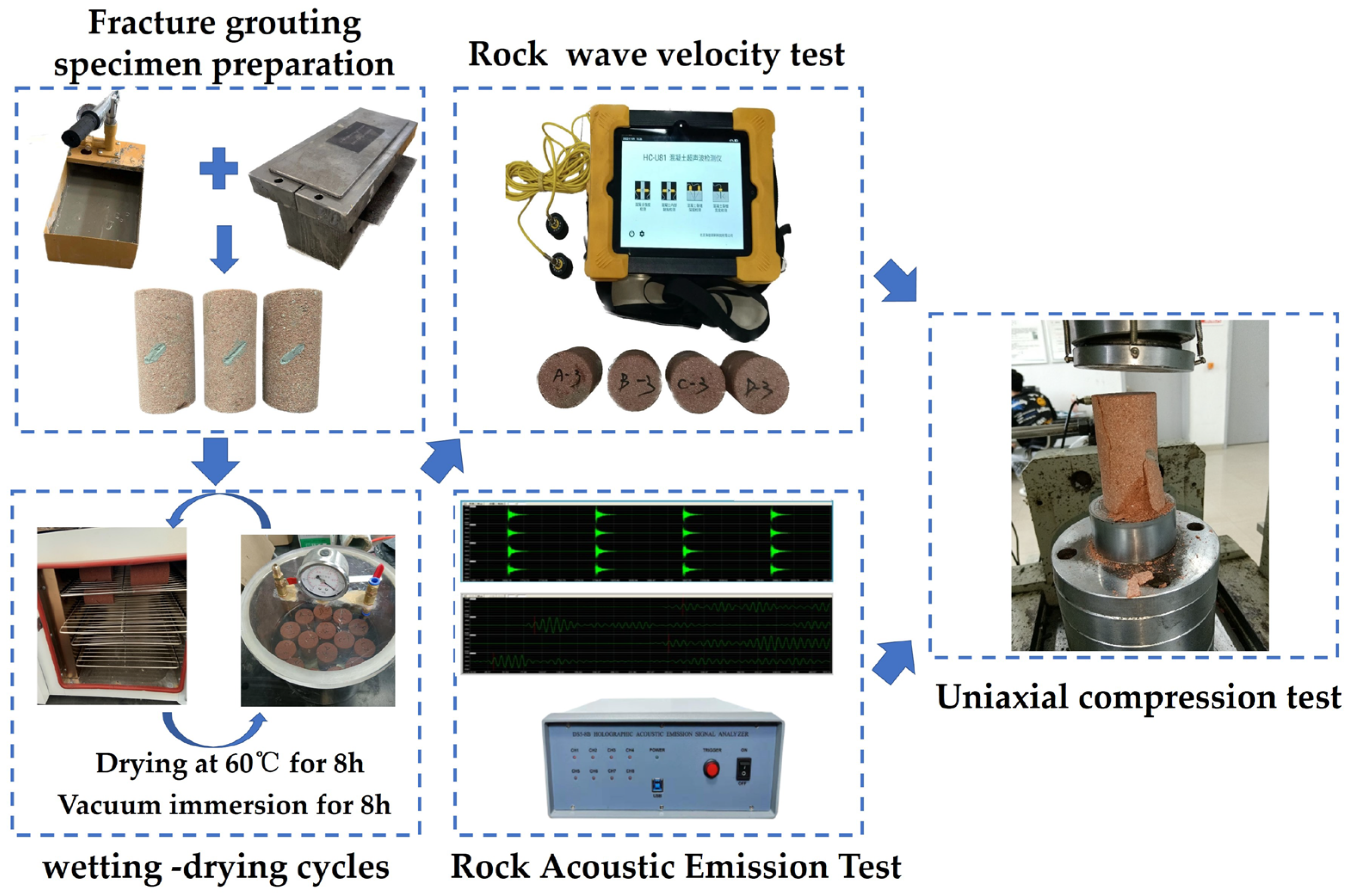
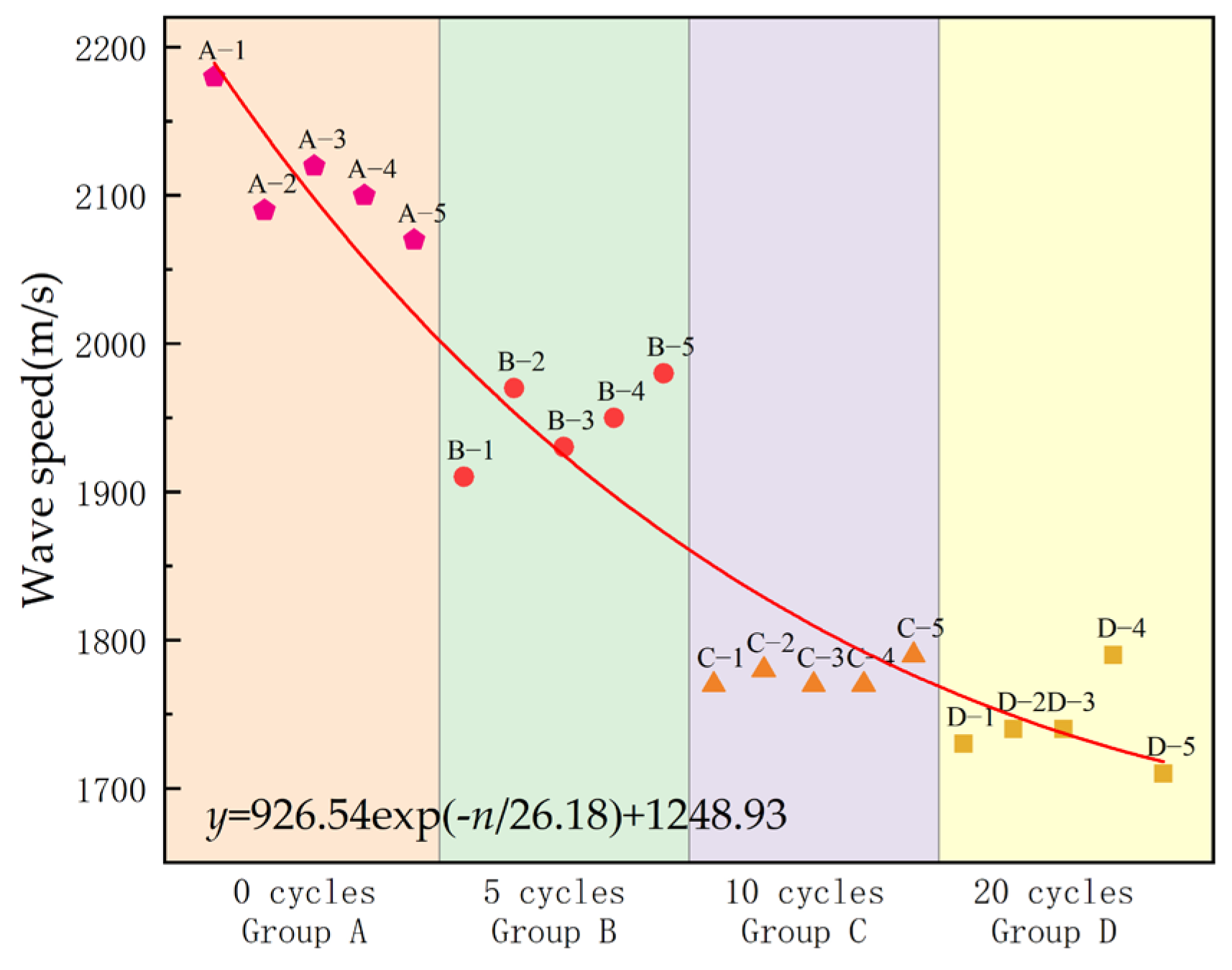
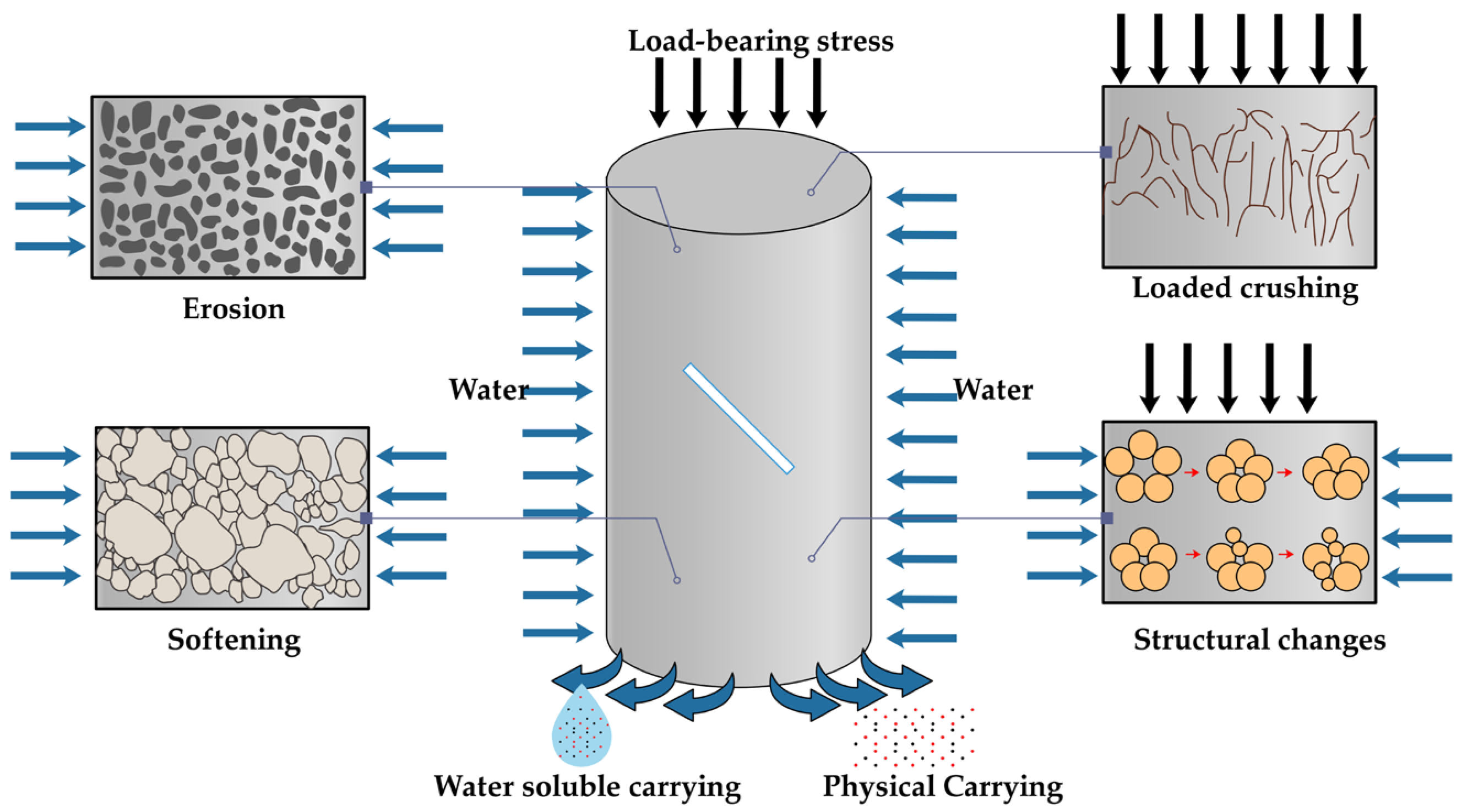
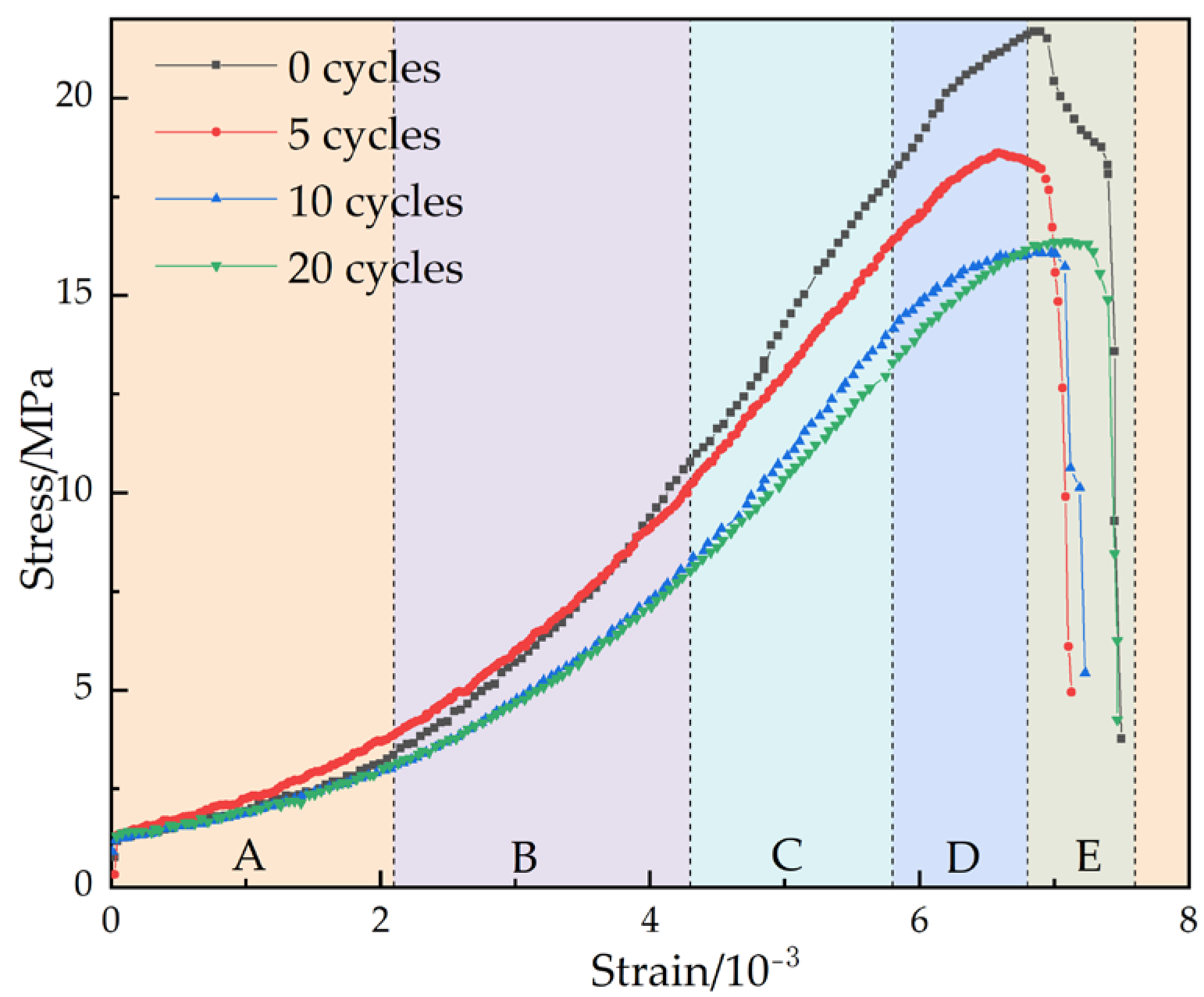

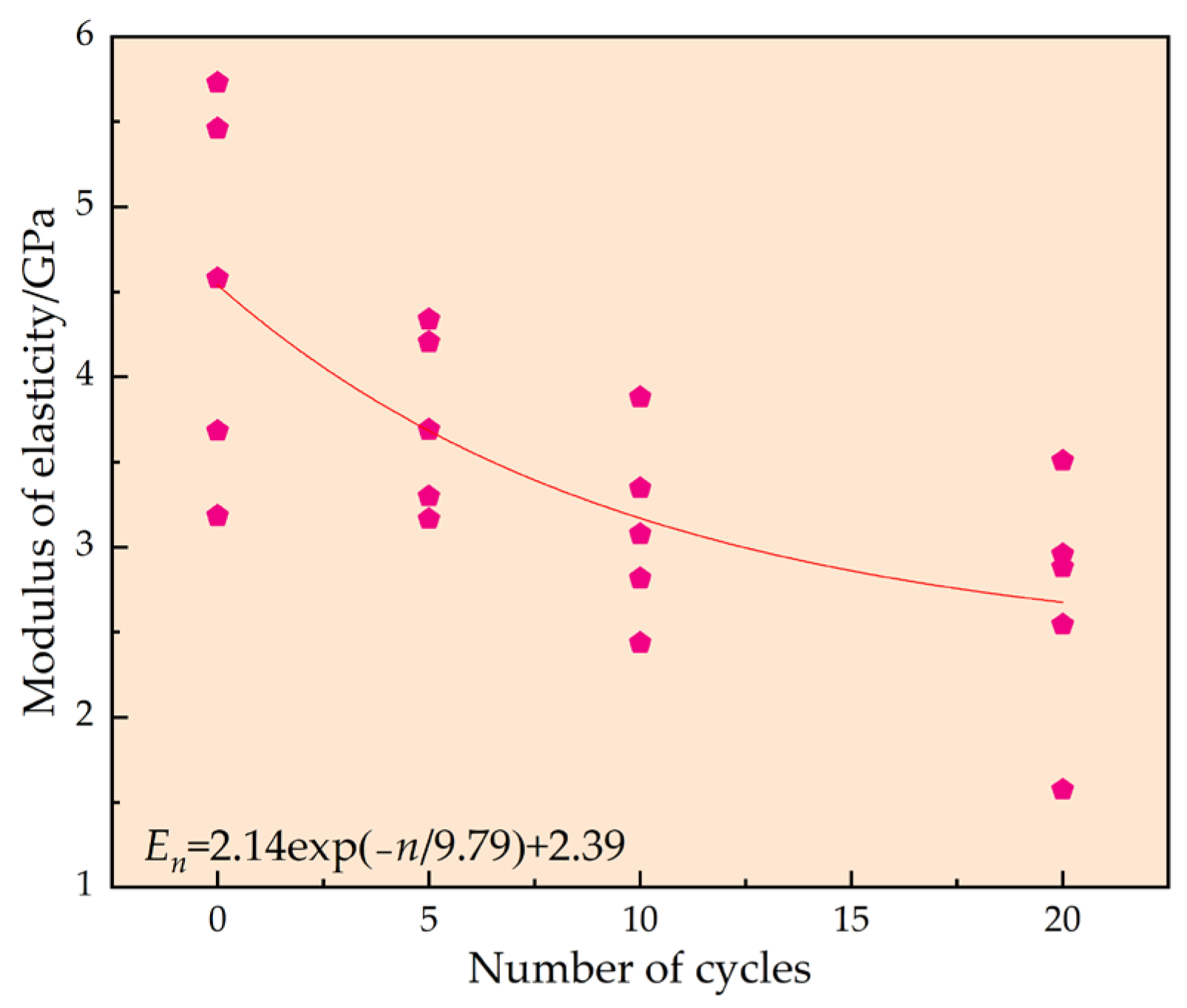

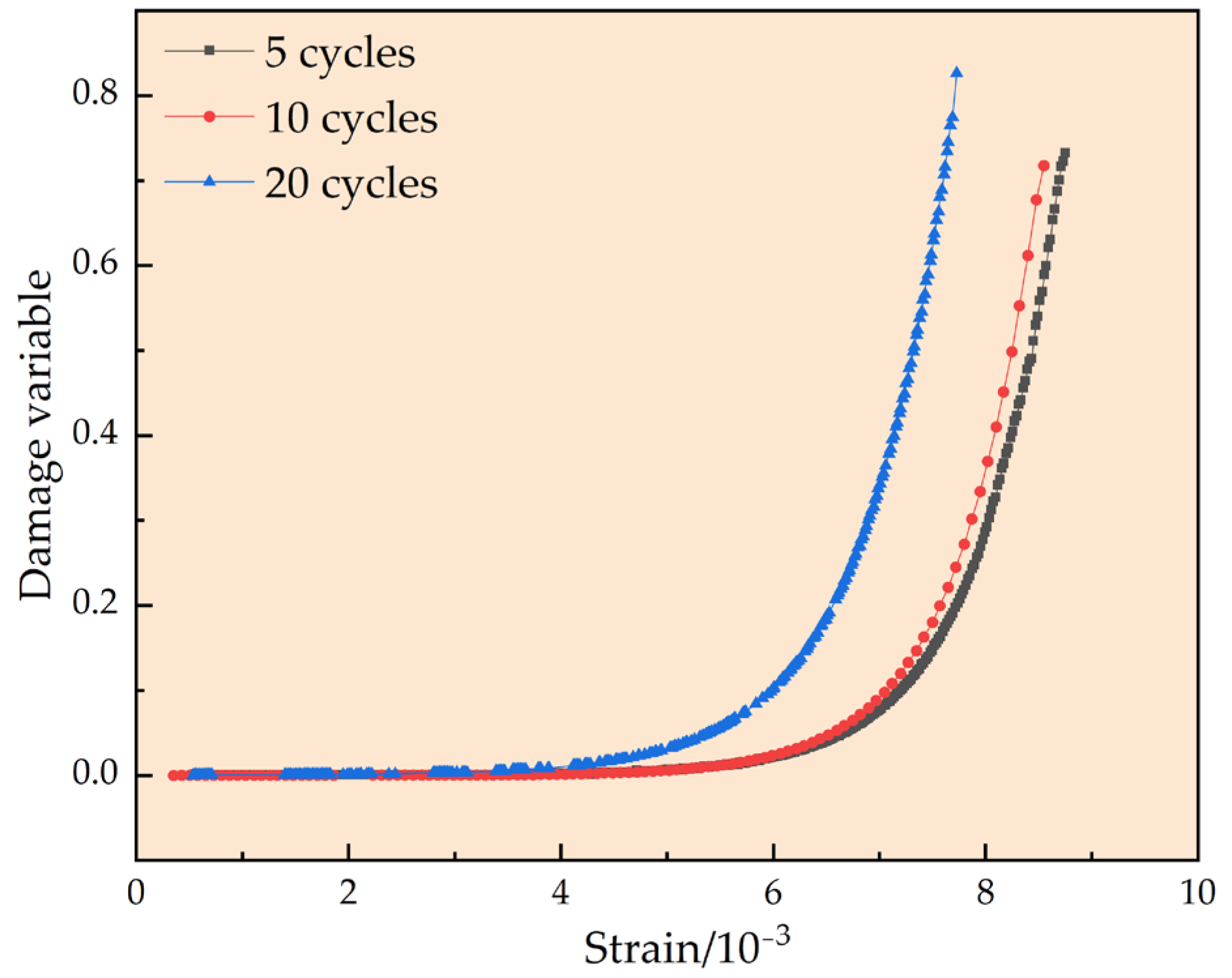
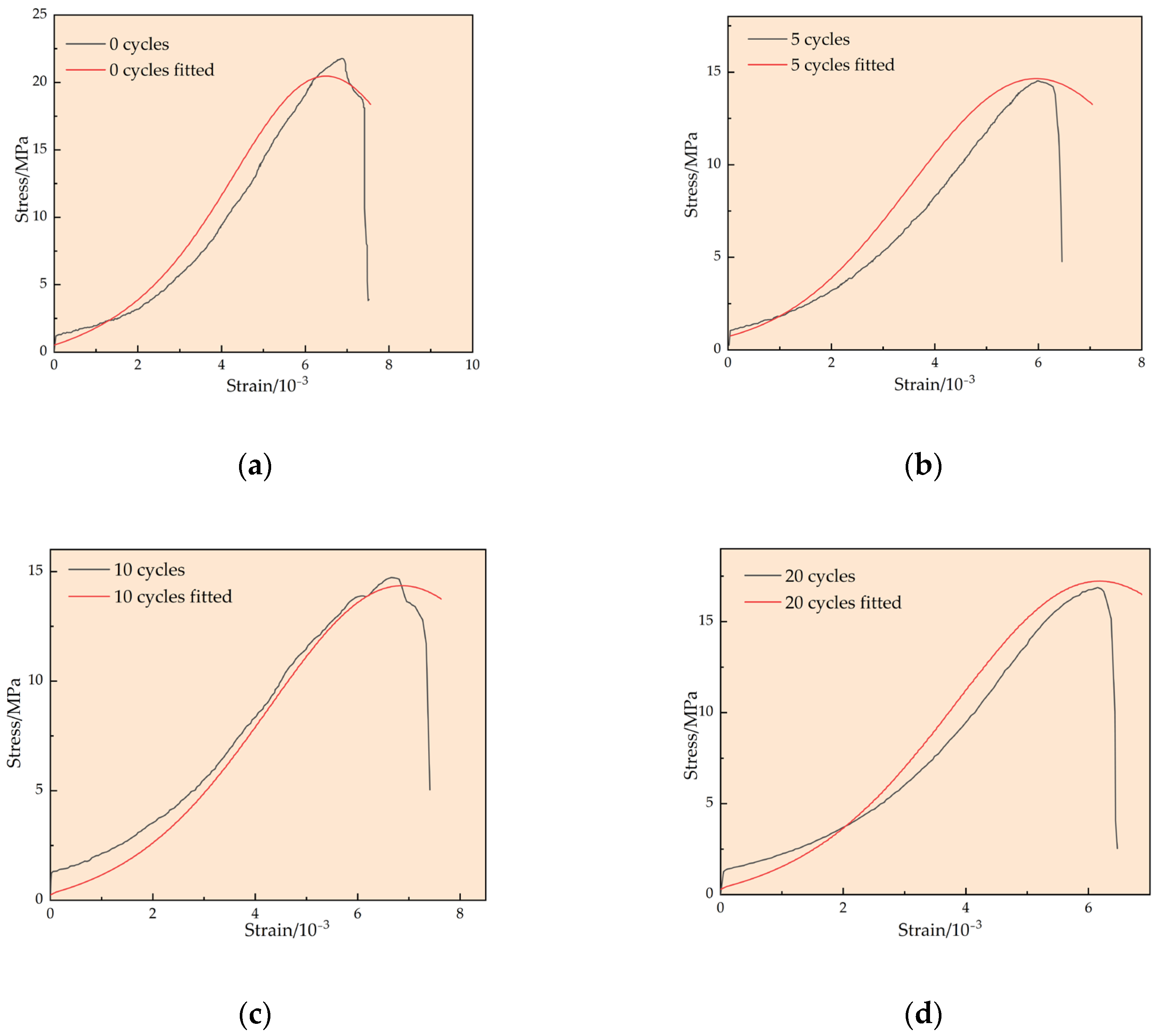
| No. | Number of Cycles | Peak Strength (MPa) | Peak Strain (%) | Modulus of Elasticity (GPa) |
|---|---|---|---|---|
| A–1 | 0 | 16.68 | 0.716 | 3.683 |
| A–2 | 0 | 21.68 | 0.685 | 4.581 |
| A–3 | 0 | 18.29 | 0.609 | 3.183 |
| A–4 | 0 | 18.01 | 0.669 | 5.73 |
| A–5 | 0 | 15.36 | 0.752 | 5.46 |
| B–1 | 5 | 18.63 | 0.599 | 3.69 |
| B–2 | 5 | 12.59 | 0.626 | 3.166 |
| B–3 | 5 | 11.74 | 0.406 | 4.206 |
| B–4 | 5 | 12.87 | 0.617 | 3.298 |
| B–5 | 5 | 12.54 | 0.624 | 4.338 |
| C–1 | 10 | 20.60 | 0.673 | 3.88 |
| C–2 | 10 | 16.67 | 0.905 | 2.436 |
| C–3 | 10 | 18.71 | 0.818 | 3.346 |
| C–4 | 10 | 16.09 | 0.698 | 3.076 |
| C–5 | 10 | 14.73 | 0.666 | 2.816 |
| D–1 | 20 | 17.88 | 0.678 | 2.546 |
| D–2 | 20 | 16.88 | 0.615 | 3.508 |
| D–3 | 20 | 15.86 | 0.669 | 2.882 |
| D–4 | 20 | 16.37 | 0.715 | 2.958 |
| D–5 | 20 | 10.30 | 0.824 | 1.575 |
Disclaimer/Publisher’s Note: The statements, opinions and data contained in all publications are solely those of the individual author(s) and contributor(s) and not of MDPI and/or the editor(s). MDPI and/or the editor(s) disclaim responsibility for any injury to people or property resulting from any ideas, methods, instructions or products referred to in the content. |
© 2023 by the authors. Licensee MDPI, Basel, Switzerland. This article is an open access article distributed under the terms and conditions of the Creative Commons Attribution (CC BY) license (https://creativecommons.org/licenses/by/4.0/).
Share and Cite
Wu, B.; Liu, Q.; Fu, Q.; Yang, Q.; Chen, Q. Damage Mechanism of Prefabricated Fracture-Grouted Rock Specimens under the Action of Dry and Wet Cycles. Appl. Sci. 2023, 13, 3631. https://doi.org/10.3390/app13063631
Wu B, Liu Q, Fu Q, Yang Q, Chen Q. Damage Mechanism of Prefabricated Fracture-Grouted Rock Specimens under the Action of Dry and Wet Cycles. Applied Sciences. 2023; 13(6):3631. https://doi.org/10.3390/app13063631
Chicago/Turabian StyleWu, Benniu, Qinjie Liu, Qiang Fu, Qinggan Yang, and Qiang Chen. 2023. "Damage Mechanism of Prefabricated Fracture-Grouted Rock Specimens under the Action of Dry and Wet Cycles" Applied Sciences 13, no. 6: 3631. https://doi.org/10.3390/app13063631
APA StyleWu, B., Liu, Q., Fu, Q., Yang, Q., & Chen, Q. (2023). Damage Mechanism of Prefabricated Fracture-Grouted Rock Specimens under the Action of Dry and Wet Cycles. Applied Sciences, 13(6), 3631. https://doi.org/10.3390/app13063631






